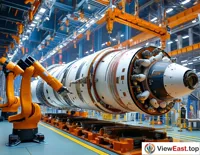






In the grand tapestry of Chinese space endeavors, the Kuaizhou-1 rocket stands out as a brilliant gem, symbolizing the innovation and commercial potential of China's space program. Developed by the China Aerospace Science and Industry Corporation (CASIC), this solid-fueled launch vehicle has not only achieved numerous technical breakthroughs but also paved new ground in the realm of commercial space launches.
The development journey of the Kuaizhou-1 was filled with innovation and challenges. Since the initiation of its research and development in 2003, the team adopted an integrated star-rocket technology, which increased the payload capacity by more than double. In 2011, the novel concepts and technologies in the Kuaizhou rocket plan were reviewed and approved by a panel of space experts. The Kuaizhou-1 rocket is characterized by its "multiple, fast, good, economical, and light" features, capable of swiftly deploying various small satellites into orbit to fulfill missions such as emergency communication, navigation, and reconnaissance.
The rapid launch capability of the Kuaizhou-1 is particularly remarkable. It can be launched within a week of the rocket and satellite's arrival at the launch site and is capable of multiple consecutive launches in a short period. This swift response ability gives the Kuaizhou-1 a significant advantage in the commercial space launch sector.
In terms of commercial rocket development, the successful launch of the Kuaizhou-1 marked a new step for China in the field of commercial space. On January 9, 2017, the Kuaizhou-1A small launch vehicle successfully sent the Jilin-1 video satellite and two cube satellites into their planned orbits, marking the "commercial first order" of the Kuaizhou rocket. This was not only a technical success but also an innovative attempt at a commercial space model.
The Kuaizhou-1 and its improved versions, the Kuaizhou-1A and Kuaizhou-11, have not only inherited the characteristics of the Kuaizhou-1 but also been optimized for commercialization, high-density, and rapid launch demands. The Kuaizhou-11 has a maximum payload capacity of 1.5 tons to low Earth orbit, meeting a variety of commercial launch needs.
The path of innovation in China's space endeavors is one filled with challenges and breakthroughs. The success of the Kuaizhou-1 demonstrates China's technical prowess in the field of solid-fueled launch vehicles and highlights the exploration and achievements of China's space program on the path to commercialization. With the support of Chinese space policies and the rapid development of the commercial space industry, the Kuaizhou series of rockets is bound to play an even greater role in the future space market, adding more brilliance to the innovative path of China's space endeavors.